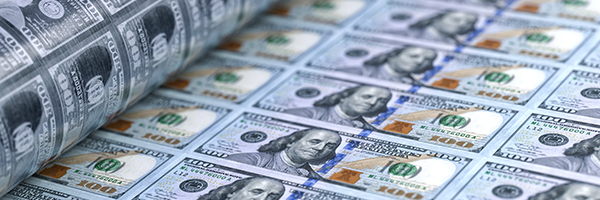
November 21, 2023 | Daily JAM |
Federal Reserve officials at their November 1 meeting were agreed on a strategy to “proceed carefully” on future interest-rate moves and base any further tightening on progress toward their inflation goal. “All participants agreed that the committee was in a position to proceed carefully and that policy decisions at every meeting would continue to be based on the totality of incoming information,” according to minutes of the November 1 Federal Open Market Committee meeting released today, Tuesday, November 21. At the meeting the Fed held its benchmark lending rate in a range of 5.25% to 5.5% for the second straight meeting.

November 17, 2023 | Daily JAM |
Until this week, the consensus was that the Federal Reserve would begin to cut interest rates in July (or maybe June.) As of Friday, November 17, however, the CME FedWatch Tool, which calculates the odds of a Fed move from prices in the FedFunds Futures market, put chances of a interest rate cut at the central bank’s May 1 meeting at better than 50%.

November 16, 2023 | Daily JAM, Morning Briefing |
More news this morning pointing to a slowing economy. Initial claims for unemployment for the past week rose 13,000 to 231,000, the Labor Department Reported this morning. That’s the highest weekly figure in three months. And is yet another sign that the economy is cooling. Which would encourage the Federal Reserve to call an end to it interest rate increases and, maybe even, start to cut rates relatively soon. At least that’s how the bond market read the numbers.

November 15, 2023 | Daily JAM |
Today stocks and bonds both paused to think about yesterday’s huge rally.
November 14, 2023 | Daily JAM, Morning Briefing |
Core Consumer Price Index inflation came in at a 4.0% annual rate in October, the Bureau of Labor Statistics reported this morning, November 14. Economists had projected a 4.1% annual rate for October. And that 1 basis point, small as it was was enough to send stocks and bonds soaring. At the close, the Standard & Poor’s 500 was up 1.91%.

November 9, 2023 | Daily JAM, Morning Briefing |
Eight days ago Federal Reserve chair Jerome Powell set off a financial market rally when the markets thought they heard him signal that the Fed was done with interest rate increases. Today, November 9, Powell very clearly said (at an International Monetary Fund conference in Washington) that the Fed won’t hesitate to raise rates if a hike is needed. Other Fed officials have recently said the same thing.

November 6, 2023 | Daily JAM, Morning Briefing, Short Term |
The financial markets continue to swing from extreme to extreme in sentiment. The markets were wrong at the beginning of last week. It’s likely the markets are wrong again.

November 3, 2023 | Daily JAM, Jubak Picks, RWM, Short Term |
On Monday, I will add to my short position in the small-cap Russell 2000 by buying more of the ProShares Short Russell 2000 ETF (RWM) for my Jubak Picks Portfolio. This buy will give me two positions in the ProShares Short Russell ETF. The first position, added to the portfolio on July 23, 2023 is up 0.08% as of the close on November 3. Why go all in on shorting the Russell now?

November 1, 2023 | Daily JAM, Morning Briefing |
Certainly, it wasn’t any surprise that at today’s meeting the Federal Reserve decided to keep its policy rate steady at 5.25% to 5.50%. Going into the meeting the CME FedWatch tool put the odds of the Fed standing pat on rates at close to 100%. So why then the huge rally in the 10-year Treasury that pushed yields down 18 basis points on the day to 4.76%?

October 31, 2023 | Daily JAM |
The “experts” expect that the Labor Department’s employment situation report on Friday, November 3, will show that the U.S. economy added 190,000 jobs in October. That would be a big drop from the 336,000 jobs added in September. But remember that these experts were projecting that the economy would add just 170,000 jobs before the September report.

October 31, 2023 | Daily JAM, Morning Briefing |
The Federal Reserve will announce its interest rate decision on Wednesday–the market currently expects no change to policy interest rates. But I’d argue that the bigger news on internet rates for the day will come when the Treasury announces how many notes and bonds it intends to sell in auctions from November through January. Right now, it looks to me like the bond market is driving interest rates rather than the Fed so the number of bonds Treasury needs to sell is likely to set interest rate trends for the next few weeks. Bloomberg’s survey of Wall Street primary bond dealers shows that the consensus projection for the quarterly refunding sales announcement—including 3-, 10- and 30-year Treasuries— is for a $114 billion total, up from the $103 billion total three months ago.

October 27, 2023 | Daily JAM, Morning Briefing |
The Personal Consumption Expenditures index, the Federal Reserve’s preferred measure of inflation, accelerated to a four-month high in September. The core Personal Consumption Expenditures index, which strips out volatile food and energy prices, rose 0.3% in September from August, according to the Bureau of Economic Analysis. As with this week’s report of a surprisingly strong 4.9% annual GDP growth, the “culprit” in today’s surprise was strong consumer spending. Inflation-adjusted consumer spending jumped 0.4% last month. The numbers in this report for inflation and earlier this week for GDP growth argue that the Federal Reserve might consider another interest rate increase in the remainder of 2023. But Wall Street sentiment doesn’t agree with that view.








